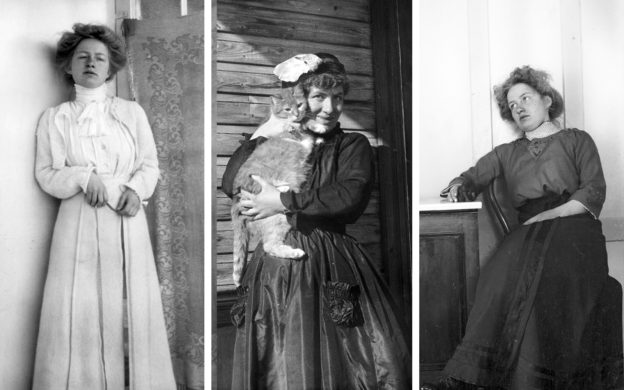The poetry of legendary Swedish-speaking Finnish poet Edith Södergran has been around for a hundred years, but never feels a day too old. The woman behind the famous poem Vierge Moderne, with the iconic phrase “I am no woman. I am a neuter” (“Jag är ingen kvinna. Jag är ett neutrum”) manages to stay relevant, as her poetry constantly gets re-discovered and loved by new generations.
Find out more about the life story of Finland’s feminist, cat-loving poet, Edith Södergran:
Edith Södergran was born in Saint Petersburg in 1892, into an affluent, upper middle-class family. She died at the young age of 31 in Raivola (then Finland, now part of Russia), after suffering from tuberculosis for a large part of her life. Södergran grew up in a Swedish speaking home in Saint Petersburg and Karelia (a historical province in Finland), but her class background allowed her to follow an international education, where she was taught in Finnish, Russian, French, and German. In fact, Södergran was never educated in Swedish but merely spoke the language at home.
 |
 |
Left: Edith Södergran’s house in Raivola; Right: Edith Södergran at home
In 1908, when Södergran was a teenager, she was diagnosed with tuberculosis. At that time, the prospects of living for more than a decade with the illness were bleak. The only treatments available were fresh air, moderate exercise, and nutritious food. Södergran had already lost her father to the disease two years earlier, and she was sent to the same sanatorium where he had died in Nummela, Finland.
In 1912, she was moved to a sanatorium in Davos, Switzerland, the then epicenter for tuberculosis treatments, where she spent around two years breathing in the fresh mountain air.
Edith was an avid letter writer and stayed in touch with like-minded people throughout her stays in sanatoriums. This allowed her to follow political developments at home, as well as elsewhere in the world. In fact, she wrote an essay advocating for universal suffrage from the sanatorium in Switzerland.
During her stay in Davos, Södergran also started studying Italian and most likely encountered futurism as a literary style for the first time through the German expressionist magazine Der Sturm.
The themes of Södergran’s poetry evolved throughout her life, starting with romantic poetry written just before and after her tuberculosis diagnosis in 1907-1909 (which was mostly written in German). Södergran repeatedly fell in love with her doctors and teachers, and her early poetry was influenced by these feelings of unrequited love. In 1908, almost from one day to the next, Södergran stopped writing in German and switched fully to writing in Swedish.

In 1916, her first collection of poetry was published, which included her famous poems Vierge Moderne, as well as The Day Cools…, in which she writes about male attention and disappointment:
You looked for a flower
and found a fruit.
You looked for a well
and found a sea.
You looked for a woman
and found a soul –
you are disappointed.
Here, her style has evolved to become more decadent and expressive. A new kind of woman, and a new kind of strong, the subjective “I” is born in Södergran’s poetry, as she writes in Vierge Moderne:
I am no woman. I am a neuter.
(…)
I am the whisper of blood in the ear of the man,
I am the soul’s ague, the longing and refusal of the flesh,
I am an entrance sign to new paradises.
Bear in mind, these poems were published before women had the right to vote in Sweden, and just 10 years after they had been given suffrage in Finland. Södergran’s depiction of the strong, mythical woman was a novelty and helped Södergran earn the reputation as one of the first modernists in Swedish literature.
Södergran’s poetry would later become increasingly expressionist and influenced by Nietzche, alongside Russian poets such as Anna Akhmatova and Zinaida Gippius, and the German poet Else Lasker-Schüler. Edith Södergran was a well-informed, multilingual woman of her time. The volatile political context – Russia’s bloody revolution and Finland’s fight for independence – have also been cited as influences in her work.
Södergran’s legacy as a poet has been wildly contested. While her poetry is sometimes reduced to the wild dreams of a woman with tuberculosis, she is also credited with being a “New Woman”, one of the first modernists in Swedish literature, and a poet that reflected on and wrote about her political and societal context.
It’s not far-fetched to assume that Södergran’s poetry stirred some bad blood (even though many critics where positive about her work), and that part of the fight over her legacy can be attributed to this. Edith Södergran’s women are strong, seductive, and invincible: they are femmes fatales, dangerous women, nasty women. The only way to de-weaponize them is to reduce their creator to a fragile woman, delirious with her illness. It can’t have been easy to swallow her confident “I”, paired with her rejection of the Man, such as in Violet Twilights:
The man hasn’t come, has never been, shall never be…
The man is a fake mirror which the sun’s daughter angrily throws against the cliff,
the man is a lie which white children don’t understand,
the man is a rotten fruit which proud lips deceive
Edith Södergran is now recognized as one of Swedens most important and influential poets, and many Swedish students are introduced to her work in high school. No doubt her depiction of women as independent, sometimes dangerous forces of nature, appeal to a generation of young feminists. Regardless of your interpretation of her work, no one can be left unmoved by her ability to put the strength of women into words.


